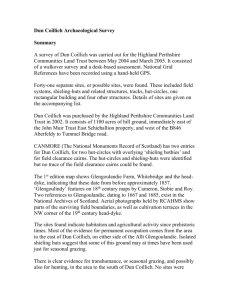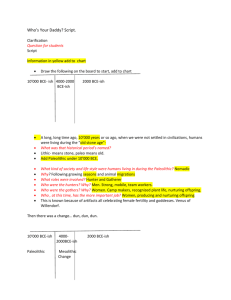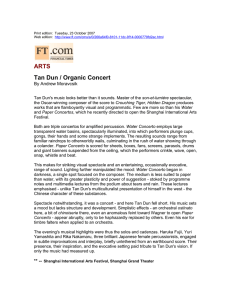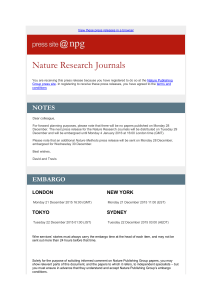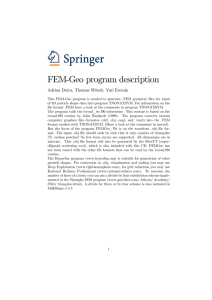Time-dependent density functional perturbation theory
advertisement
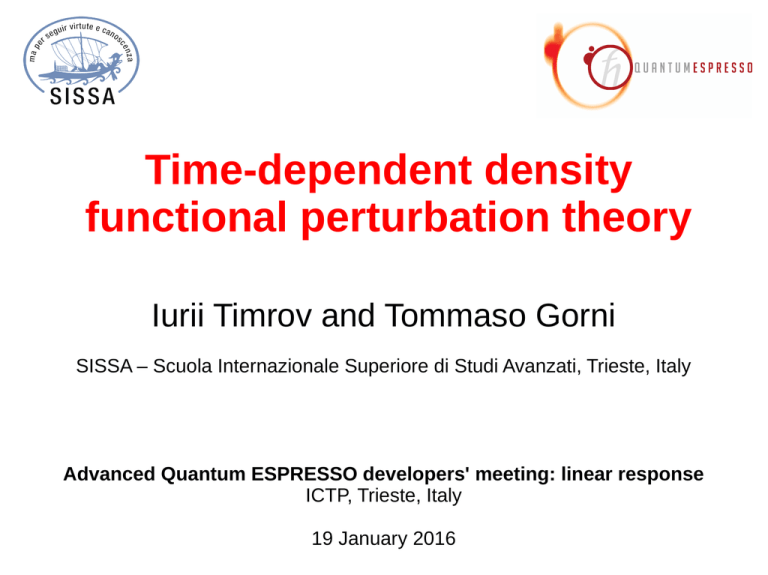
Time-dependent density functional perturbation theory Iurii Timrov and Tommaso Gorni SISSA – Scuola Internazionale Superiore di Studi Avanzati, Trieste, Italy Advanced Quantum ESPRESSO developers' meeting: linear response ICTP, Trieste, Italy 19 January 2016 Outline 1. Introduction to the TDDFPT module of QE 2. Absorption spectroscopy for finite systems 3. Electron energy loss spectroscopy for periodic systems 4. Conclusions Outline 1. Introduction to the TDDFPT module of QE 2. Absorption spectroscopy for finite systems 3. Electron energy loss spectroscopy for periodic systems 4. Conclusions Developers of the TDDFPT module ● Stefano Baroni (2004 – present), coordinator ● Ralph Gebauer (2004 – present) ● Brent Walker (2004 – 2006) ● Dario Rocca (2006 – 2012) ● Baris Malcioglu (2008 – 2010) ● Simon Binnie (2010 – 2012) ● Xiaochuan Ge (2010 – present) ● Iurii Timrov (2010 – present) ● Tommaso Gorni (2014 - present) The timing is approximate. Schematic illustration of the dependencies What is now TDDFPT PHonon PWscf Schematic illustration of the dependencies What is now TDDFPT What is desired... PHonon TDDFPT PHonon Linear-response module PWscf PWscf Components of the TDDFPT module TDDFPT Absorption spectroscopy turboTDDFT Electron energy loss spectroscopy turboEELS These two codes are strongly interleaved and reside in the same repository, namely TDDFPT/src . Components of the TDDFPT module TDDFPT Absorption spectroscopy turboTDDFT Electron energy loss spectroscopy turboEELS These two codes are strongly interleaved and reside in the same repository, namely TDDFPT/src . Outline 1. Introduction to the TDDFPT module of QE 2. Absorption spectroscopy for finite systems 3. Electron energy loss spectroscopy for periodic systems 4. Conclusions Absorption spectroscopy turboTDDFT Liouville-Lanczos approach turbo_lanczos.x Casida-Davidson approach turbo_davidson.x Bibliography 1. B. Walker, R. Gebauer, Ultrasoft pseudopotentials in time-depepndent density-functional theory, J. Chem. Phys. 127, 164106 (2007). 2. D. Rocca, R. Gebauer, Y. Saad, and S. Baroni, Turbo charging time-dependent density-functional theory with Lanczos chains, J. Chem. Phys. 128, 154105 (2008). 3. O. Malcioglu, R. Gebauer, D. Rocca, and S. Baroni, turboTDDFT – A code for the simulation of molecular spectra using the Liouville-Lanczos approach to TDDFPT, Comp. Phys. Comm. 182, 1744 (2011). 4. S. Baroni and R. Gebauer, 'The Liouville-Lanczos approach to TDDFPT' in 'Fundamentals of TDDFT', Springer, Berlin (2012). 5. X. Ge, S. Binnie, D. Rocca, R. Gebauer, and S. Baroni, turboTDDFT 2.0 – Hybrid functionals and new algorithms within TDDFPT, Comp. Phys. Comm. 185, 2080 (2014). 6. I. Timrov, O. Andreussi, A. Biancardi, N. Marzari, and S. Baroni, Self-consistent continuum solvation for optical absorption of complex molecular systems in solution, J. Chem. Phys. 142, 034111 (2015). Restrictions of the turboTDDFT code Absorption spectroscopy turboTDDFT Liouville-Lanczos approach turbo_lanczos.x Casida-Davidson approach turbo_davidson.x Liouville-Lanczos approach: basic equations Coupled linear-response TDDFPT equations (resonant and anti-resonant): perturbation These equations can be re-written as a quantum Liouville equation: interaction terms Absorption coefficient is computed as: Lanczos algorithm is used to solve recursively quantum Liouville equation in the standard batch representation. This allows us to avoid inversions and multiplications of large matrices. Liouville-Lanczos approach: implementation perturbation TDDFPT/lr_dvpsi_e.f90 (analogue of PH/dvpsi_e.f90) External electric field inducing a dipole moment: PH/commutator_Hx_psi.f90 Projector on empty states: S. Baroni, S. de Gironcoli, A. Dal Corso, and P. Giannozzi, Rev. Mod. Phys. 73, 515 (2001) No empty states! PH/orthogonalize.f90 Liouville-Lanczos approach: implementation TDDFPT/lr_apply_liouvillian.f90 Liouville-Lanczos approach: implementation TDDFPT/lr_apply_liouvillian.f90 PW/h_psi.f90 PH/dv_of_drho.f90 TDDFPT/lr_calc_dens.f90 Liouville-Lanczos approach: SBR In the actual implementation of the Liouville-Lanczos approach, the so called standard batch representation (SBR) is used (rotation of 45 degrees): In the SBR, the matrix linear-response equation have a block-diagonal form: This allows us to decrease the number of operations by a factor of 2. D. Rocca, R. Gebauer, Y. Saad, and S. Baroni, J. Chem. Phys. 128, 154105 (2008). Liouville-Lanczos approach: Lanczos algorithm Iterative (recursive) solver of the matrix linear-response equation in SBR. Tridiagonal matrix is generated TDDFPT/lr_lanczos.f90 Post-processing calculation of the absorption coefficient at various frequencies: TDDFPT/tools/lr_calculate_spectrum.f90 Two flavors of the Lanczos algorithm: ● Non-Hermitian ● Pseudo-Hermitian (2 times faster) coefficients are computed on the fly Liouville-Lanczos approach: ultrasoft case PW/h_psi.f90 PW/s_psi.f90 PW/newq TDDFPT/sm1_psi.f90 TDDFPT/lr_ortho.f90 B. Walker and R. Gebauer, JCP 127, 164106 (2007) TDDFPT/lr_dvpsi_e.f90 PH/commutator_Hx_psi.f90 PH/orthogonalize.f90 PH/cgsolve_all.f90 PW/compute_qdipol.f90 PH/adddvepsi_us.f90 J. Tobik and A. Dal Corso, JCP 120, 9934 (2004). Liouville-Lanczos approach: ultrasoft case The response charge-density reads: TDDFPT/lr_calc_dens.f90 The projector on empty states: TDDFPT/lr_ortho.f90 (analogue of PH/orthogonalize.f90) B. Walker and R. Gebauer, JCP 127, 164106 (2007) Liouville-Lanczos approach: hybrid functionals In hybrid functionals, a fraction of the local exchange potential is replaced by the same fraction of the non-local exact-exchange (EXX) potential (e.g. in PBE0, ). PW/exx.f90 TDDFPT/lr_exx_kernel.f90 X. Ge, S. Binnie, D. Rocca, R. Gebauer, S. Baroni, Comp. Phys. Commun. 185, 2080 (2014). Liouville-Lanczos approach + www.quantum-environment.org Inclusion of the environmental effects is very important for the correct prediction of the optical properties of the molecular systems. explicit solvent continuum solvent (atomistically resolved) (homogeneous dielectric medium) inside of the cavity there is vacuum outside of the cavity there is a dielectric medium with a dielec. constant of the solvent O. Andreussi, I. Dabo, N. Marzari, J. Chem. Phys. 136, 064102 (2012). Liouville-Lanczos approach + turboTDDFT code is interfaced with the Environ module. Environ/solvent.f90 Environ/solvent_tddfpt.f90 In the present implementation (QE 5.3.0), Environ-related routines in TDDFPT are inside of the #ifdef __ENVIRON … #endif condition. In the future releases, Environ-related routines in TDDFPT are planned to be patched as e.g. in PW. I. Timrov, O. Andreussi, A. Biancardi, N. Marzari, and S. Baroni, J. Chem. Phys. 142, 034111 (2015). Absorption spectroscopy turboTDDFT Liouville-Lanczos approach turbo_lanczos.x Casida-Davidson approach turbo_davidson.x Casida-Davidson approach: basic equations Coupled linear-response TDDFPT equations (resonant and anti-resonant): These equations can be re-written as Casida's matrix equation: interaction terms where and Davidson algorithm is used to solve the Casida's equations and to obtain the eigenvalues of the Liouvillian, which are used for a calculation of the absorption coefficient. X. Ge, S. Binnie, D. Rocca, R. Gebauer, and S. Baroni, Comput. Phys. Commun. 185, 2080 (2014). Casida-Davidson approach ● The turbo_davidson.x code supports the same features as the turbo_lanczos.x code: (i.e. ultrasoft implementation, hybrid functionals, Environ, etc.). ● ● All Davidson subroutines are collected in one module TDDFPT/lr_dav_routines.f90 The dependencies of turbo_davidson.x on PW and PHonon codes are the same as of turbo_lanczos.x. The details of the theory about the Casida-Davidson approach can be found here: X. Ge, PhD thesis “Seeing colors with TDDFT”, SISSA (2013). Absorption spectroscopy turboTDDFT Liouville-Lanczos approach Casida-Davidson approach turbo_lanczos.x turbo_davidson.x !!! Outline 1. Introduction to the TDDFPT module of QE 2. Absorption spectroscopy for finite systems 3. Electron energy loss spectroscopy for periodic systems 4. Conclusions Components of the TDDFPT module TDDFPT Absorption spectroscopy turboTDDFT Electron energy loss spectroscopy turboEELS These two codes are strongly interleaved and reside in the same repository, namely TDDFPT/src . Restrictions of the turboEELS code ● Linear response regime ● General k points algorithm. No gamma_only tricks. ● Supports NC and US pseudopotentials. No PAW. ● Hybrid functionals are not supported. ● Adiabatic XC kernels only. ● ● ● Unpolarized (nspin=1) and noncollinear (noncolin=.true.) cases are supported, while the collinear case (nspin=2) is not. Relativistic effects (spin-orbit coupling) are supported, but only with norm-conserving pseudopotentials. Parallelization: PWs, k points. Electron energy loss spectroscopy (EELS) Inelastic scattering of incoming electrons - transferred momentum - energy loss Perturbation: incoming electrons (plane waves) ● Use of lattice-periodicity ● Use of time-reversal symmetry ● Use of monochromatic decomposition wrt q Single-particle excitations and collective excitations (plasmons) I. Timrov, PhD thesis, École Polytechnique (LSI), France (2013). I. Timrov, N. Vast, R. Gebauer, and S. Baroni, PRB 88, 064301 (2013); ibid. 91, 139901 (2015). Liouville-Lanczos approach for EELS: basic equations Coupled linear-response TDDFPT equations (resonant and anti-resonant): interaction terms perturbation These equations can be re-written as a quantum Liouville equation: Susceptibility Loss function: Liouville-Lanczos approach for EELS: implementation perturbation TDDFPT/lr_dvpsi_eels.f90 PH/orthogonalize.f90 Projector on empty states: Non-SCF calculation at k+q is needed TDDFPT/lr_setup_nscf.f90 (analogue of PH/set_defaults_pw.f90) S. Baroni, S. de Gironcoli, A. Dal Corso, and P. Giannozzi, RMP. 73, 515 (2001). No empty states! TDDFPT/lr_run_nscf.f90 (analogue of PH/run_nscf.f90) Liouville-Lanczos approach for EELS: implementation perturbation TDDFPT/lr_dvpsi_eels.f90 Different ordering of the G vectors PH/cft_wave.f90 Inverse Fourier (+1) or Fourier (-1) transform of a wavefunction +1 : order as k+G -1 : order as k+q+G Liouville-Lanczos approach for EELS: implementation TDDFPT/lr_apply_liouvillian_eels.f90 Liouville-Lanczos approach for EELS: implementation TDDFPT/lr_apply_liouvillian_eels.f90 TDDFPT/lr_dv_of_drho_eels.f90 TDDFPT/lr_calc_dens_eels.f90 PH/h_psiq.f90 Liouville-Lanczos approach for EELS: implementation ● ● In the actual implementation of the Liouville-Lanczos approach for EELS, the standard batch representation (SBR) is used (as in turboTDDFT). In the turboEELS code the same Lanczos algorithm is used as in turboTDDFT. TDDFPT/lr_lanczos.f90 TDDFPT/tools/lr_calculate_spectrum.f90 ● Use of the symmetry of the small group of q TDDFPT/lr_sym_eels.f90 (analogue of PH/symdvscf.f90) TDDFPT/lr_psym_eels.f90 (analogue of PH/psymdvscf.f90) TDDFPT/lr_smallgq.f90 (analogue of PH/smallg_q, PH/smallgq) ● Description of the turboEELS code can be found here: I. Timrov, N. Vast, R. Gebauer, and S. Baroni, Comput. Phys. Commun. 196, 460 (2015). Liouville-Lanczos approach for EELS: spin-orbit coupling The turboEELS code supports spin-orbit coupling, but only with normconserving pseudopotentials. Two-component spinor wavefunctions Contains the spin-orbit coupling term ● Non-collinear case ● Requires fully relativistic PP's PH/apply_dpot.f90 PH/addusdbec_nc.f90 PH/set_dbecsum_nc Liouville-Lanczos approach for EELS: ultrasoft case PH/h_psiq.f90 PH/newdq.f90 PH/adddvscf.f90 TDDFPT/sm1_psi.f90 TDDFPT/lr_addus_dvpsi.f90 PH/orthogonalize.f90 I. Timrov, T. Gorni, A. Dal Corso, N. Vast, S. Baroni, et al. (unpublished). Liouville-Lanczos approach for EELS: ultrasoft case The response charge-density reads: TDDFPT/lr_calc_dens_eels.f90 (analogue of PH/incdrhoscf.f90) PH/addusdbec.f90 TDDFPT/lr_addusddens.f90 (analogue of PH/addusddens.f90) I. Timrov, T. Gorni, A. Dal Corso, N. Vast, S. Baroni, et al. (unpublished). Perspectives ● Generalization of TDDFPT to magnetic systems (magnons) ● Generalization of the turboEELS code to hybrid functionals (excitons) Thank you for your attention!
